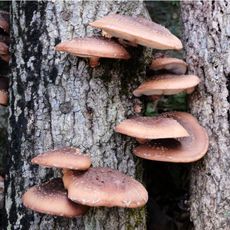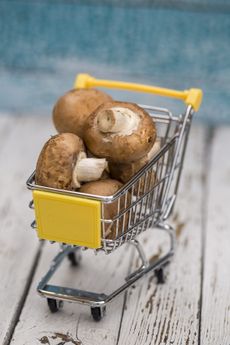Types Of Edible Mushrooms & Their Poisonous Look-Alikes
Types Of Edible Mushrooms & Their Dangerous Doppelgangers


Wild foraging is a wonderful way to expand your palate and save money. Many wild foods require a permit to harvest them, and there may be restrictions. Mushrooms are one of the best foraged foods. There are many types of edible mushrooms but a few are quite poisonous. Before you go wild foraging for mushrooms, be sure you’re armed with knowledge on identification and variety to prevent injury or even death. The difference between edible and poisonous mushroom species is sometimes very subtle, and only an expert can tell the difference.
How to Identify Edible Mushroom Varieties
Edible mushroom identification is based on body and cap forms, color, gills, size, spore print, texture, and more. Even where the fungi grow can be a clue as to the mushroom variety. There are around 10,000 species of the fungi in the United States, but less than 5 percent are poisonous. Around 30 common kinds of edible mushrooms are native in North America. The rule of thumb in gathering mushrooms is if you don’t know what it is, don’t eat it.
What to Look For
Edible and toxic mushrooms tend to live on dead and decaying matter. They also prefer a moist environment. Look around stumps and snags and at the base of trees. Organic soils, burnt or disturbed sites, and along waterways are great places to find mushrooms.
Identification is the most important part of mushroom foraging. Some mushrooms, such as morel, are very recognizable. And most edible mushrooms do not have a common doppelganger. But lurking in the forests and fields, some very toxic species can be found.
Don’t Fall for Folklore
Poisonous mushrooms were once called toadstools. In essence, they look no different than any variety of edible mushroom. Most have stems, caps, gills, and other similar features.
Old folk tales told us that if an animal eats it, it is safe, and that waiting for some time with no ill effects means the ingested fungus was safe. Neither is true! Nor is the fallacy that cooking a toxic mushroom will render it safe. Other old-school tests are also not fully true. Some claimed a toxic mushroom will tarnish silver, or that white mushrooms are safe to eat. Others assert that If a mushroom grows on wood, or in meadows or pastures, it is not poisonous. There is even a rumor that peeling a toxic mushroom makes it inert. None of these are true and only proper education and identification can truly indicate which species are safe to consume.
Common Types of Edible Mushrooms
Morel Mushrooms
Morels are instantly recognizable even to a novice forager. They have pert caps with a honeycomb texture. The meat is white and the mushroom is hollow inside. They are difficult to find, but the effort is worth it. There are 18 different species of morel in hues of black, tan, yellow, and gray. They are prized for their buttery flavor.
Gardening tips, videos, info and more delivered right to your inbox!
Sign up for the Gardening Know How newsletter today and receive a free download of our most popular eBook "How to Grow Delicious Tomatoes."
Poisonous Morel Mushroom Look-alikes:
- A common fungus, the false morel is almost the spitting image of its edible cousin except it is not hollow inside and contains cottony material.
- Big red is similar except it has reddish tones and the cap is more brain-like.
- Wrinkled thimble cap truly looks like a morel except its wrinkled cap hangs over the stem.
- Bell morel is smaller and the cap, although similar, is much less textured and it has a cottony interior.
Chanterelle Mushrooms
This mushroom forms a symbiotic relationship with trees. It is a delicious variety with several species in shades of pink, orange, yellow, and cream. It is shaped like a goblet, or cup. They bear blunt false gills that run under the cap. Chanterelles are a very popular culinary treat.
Poisonous Chanterelle Mushroom Look-alikes:
- Jack-O-Lantern Mushrooms
- Rust Gill Fungi
- False Chanterelles
Oyster Mushrooms
This fungus grows in groups, with short off-center stems. They come in hues of gray, pink, and light brown with white gills. In most areas oyster mushrooms can be found in every season but summer.
Poisonous Oyster Mushroom Look-alikes:
- The olive oysterling has yellow gills and a smaller, shorter cap than oyster mushrooms.
Lion’s Mane Mushrooms
Like a cascade of icicles, a lion's mane has a waterfall of creamy white material instead of a cap.
Poisonous Lion’s Mane Mushroom Look-alikes:
- This distinctive mushroom has no look-alikes.
Puffball Mushrooms
The cap is rounded, ball-like, and white. It may or may not have a stem. The interior is fleshy when young.
Poisonous Puffball Mushroom Look-alikes:
- Stinkhorn- when immature the interior will be gooey
- Amanita- when young it is very round, white, and egg-like
Shiitake Mushrooms
Shiitakes have caps shaped like umbrellas. They are brown with some white speckling and a slender stem.
Poisonous Shiitake Mushroom Look-alikes
- The aptly named Funeral Bell looks very similar to shiitake with the same form and basic coloring, but it has a faint ring of lighter brown on the cap.
Shaggy Mane Mushrooms
This fungus has a tall, narrow cap adorned with shaggy skin. It is white or black, and stands on a slender stalk.
Poisonous Shaggy Mane Mushroom Look-alikes:
- The Green Spored Parasol mushroom also has shaggy skin but the cap is rounder, it grows lower to the ground, and the stem is thicker.
Stropharia Mushrooms
King Stropharia, or the Garden Giant, has a reddish brown cap, gray gills, and fibrous stem. The stem has a rough edge around the top like a crown. Also called Wine Cap.
Poisonous Stropharia Mushroom Look-alikes:
- It is difficult to mistake Stropharia when they are mature and the wine-colored cap is evident. Very novice foragers could mix it up with mushrooms in the genus Agaricus, although these have pink gills.
Note: This article is for educational purposes only and should not be used as a comprehensive guide. Always seek personal, hands-on expert advice before eating wild foraged mushrooms.

Bonnie Grant is a professional landscaper with a Certification in Urban Gardening. She has been gardening and writing for 15 years. A former professional chef, she has a passion for edible landscaping.
-
 Cheap Fence Ideas For A Pretty And Private Yard
Cheap Fence Ideas For A Pretty And Private YardYou don’t need to spend a fortune to box in your garden. Take these cheap fencing ideas for your garden and budget and run with them.
By Mary Ellen Ellis
-
 How To Attract Cardinals – Get Beautiful Songbirds Flocking To Your Yard
How To Attract Cardinals – Get Beautiful Songbirds Flocking To Your YardThe northern cardinal is a national treasure and a delight to spot in the garden, nesting in shrubbery and flitting between feeders. Discover how to attract this beloved songbird by providing the right food, shelter, and water.
By Melanie Griffiths
-
 Which Types Of Wood To Use For Growing Fungi
Which Types Of Wood To Use For Growing FungiWondering about the best logs for mushroom plugs? Match the mushroom type to the tree variety for a great crop of delicious mushrooms.
By Bonnie L. Grant
-
 Make Your Own Mushroom Coffee From Homegrown Fungi
Make Your Own Mushroom Coffee From Homegrown FungiWhat is mushroom coffee? Can you make your own mushroom coffee at home? Click here to learn more.
By Laura Miller
-
 Growing Mushrooms In Coffee Grounds At Home
Growing Mushrooms In Coffee Grounds At HomeLearn how re-using coffee grounds for mushroom substrate is great for the mushrooms and good for the planet.
By Bonnie L. Grant
-
 How To Grow Morel Mushrooms: Growing Morel Mushrooms At Home
How To Grow Morel Mushrooms: Growing Morel Mushrooms At HomeMorel mushroom growing conditions are difficult to pinpoint. Some expert tips are necessary on how to grow morel mushrooms.
By Bonnie L. Grant
-
 Home Canning Mushrooms – Tips For Storing Mushrooms In Jars
Home Canning Mushrooms – Tips For Storing Mushrooms In JarsAre you contemplating home canning mushrooms, but are nervous about safety? Click here to explore how to can mushrooms safely.
By Laura Miller
-
 Enoki Mushroom Info – Tips For Growing Enoki Mushrooms Yourself
Enoki Mushroom Info – Tips For Growing Enoki Mushrooms YourselfEnoki mushrooms are very delicate fungi in an almost filament form. They are often the only mushrooms available in winter. If you like eating enoki mushrooms, you might try growing them yourself. Learn more about enoki mushrooms and how to grow them here.
By Bonnie L. Grant
-
 Growing Mushrooms At Home: How To Make A Mushroom Fruiting Chamber
Growing Mushrooms At Home: How To Make A Mushroom Fruiting ChamberSetting up a mushroom fruiting chamber is really the only difficult thing about growing mushrooms at home, and even then, a DIY mushroom house doesn’t have to be complex. To learn how to make your own mushroom fruiting chamber, click the following article.
By Amy Grant
-
 Propagating Store Bought Mushrooms: How To Grow Mushrooms From Ends
Propagating Store Bought Mushrooms: How To Grow Mushrooms From EndsPropagating store bought mushrooms from the ends just requires a good fruiting medium, moisture and the proper growing environment. Click on this article to learn how to grow mushrooms from ends.
By Bonnie L. Grant